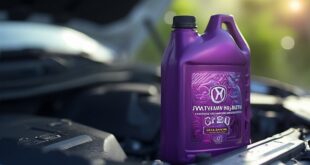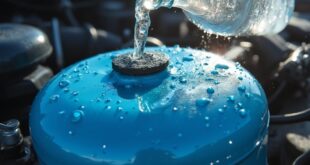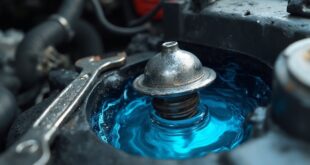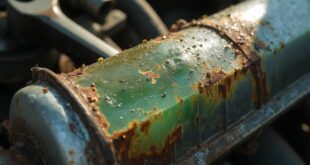The coolant overflow tank functions by holding excess coolant to maintain pressure and balance within the engine cooling system. As temperatures rise, it withdraws coolant to prevent loss due to evaporation and accommodates coolant when pressure increases. This process helps regulate engine temperature, prevents overheating, and enhances performance. Constructed from durable plastic, it features a fill line and sight glass for monitoring levels. Additional insights into maintenance and signs of issues are available for further understanding.
Function of the Coolant Overflow Tank
The coolant overflow tank plays an essential role in maintaining the efficiency and effectiveness of a vehicle's cooling system.
It serves to hold coolant, ensuring system balance and regulating pressure during operation. As temperatures rise, the tank withdraws excess coolant when levels drop, while simultaneously accepting coolant during pressure increases. This process prevents coolant loss due to evaporation or leakage.
Importance in Engine Cooling System
Although often overlooked, the coolant overflow tank is essential for the efficient operation of an engine's cooling system.
It plays a vital role in maintaining ideal coolant levels, which helps regulate engine temperature and prevents overheating. By accepting excess coolant during pressure increases and supplying it back when levels drop, the tank guarantees a balanced system. This function not only enhances engine performance but also prolongs its lifespan.
In addition, the overflow tank minimizes environmental impact by preventing toxic antifreeze from leaking, thereby safeguarding both the vehicle's integrity and surrounding ecosystems.
Its importance cannot be understated in modern automotive engineering.
Main Components Involved
A well-functioning cooling system relies on several essential components working together to regulate engine temperature effectively. Key components include the radiator, which serves as a heat exchanger, and the thermostat, which controls coolant flow based on temperature. The water pump circulates coolant, ensuring efficient heat dispersal. Additionally, the radiator cap maintains system pressure, while hoses connect the various parts, providing durability under high temperatures.
| Component | Function | Material |
|---|---|---|
| Radiator | Heat exchanger | Typically aluminum |
| Thermostat | Controls coolant flow | N/A |
| Water Pump | Circulates coolant | N/A |
Specifications of the Coolant Overflow Tank
Coolant overflow tanks are designed with specific features to guarantee peak performance within the vehicle's cooling system.
Typically constructed from durable, heat-resistant plastic, these tanks are equipped with a cap to maintain system pressure. They include a fill line that indicates the ideal coolant level and often have a sight glass for easy monitoring.
Connected to the radiator via a hose, the overflow tank facilitates coolant transfer as temperatures fluctuate, ensuring efficient operation.
These specifications contribute to the tank's essential role in managing coolant levels and protecting the overall integrity of the vehicle's cooling system.
Monitoring Coolant Levels
Monitoring coolant levels is crucial for maintaining the efficiency of a vehicle's cooling system. Regular checks can prevent overheating and guarantee peak performance. The coolant overflow tank typically has indicators for safe operating levels, guiding users in their inspections.
| Coolant Level | Status | Action Needed |
|---|---|---|
| Above Fill Line | Normal | No action required |
| At Fill Line | Caution | Add coolant soon |
| Below Fill Line | Critical | Add coolant immediately |
| Empty | Danger | Stop engine; refill coolant |
Maintaining appropriate coolant levels is essential for engine longevity.
Maintenance Tips for Longevity
While ensuring the longevity of a vehicle's cooling system, routine maintenance of the coolant overflow tank plays an essential role.
Regular upkeep can prevent costly repairs and enhance performance.
Key maintenance tips include:
- Check coolant levels frequently, ensuring they remain above the minimum threshold.
- Inspect the overflow tank and hoses for any signs of cracks or leaks.
- Replace old or contaminated coolant according to the manufacturer's recommendations.
Signs of Potential Issues
What indicators suggest potential issues with the coolant overflow tank? A low coolant level in the overflow tank often points to leaks or evaporation problems.
Moreover, visible leaks around the tank or connecting hoses can indicate compromised components. An overheating engine temperature gauge may signal inadequate coolant circulation or a malfunctioning system.
In addition, discolored or contaminated coolant suggests possible contamination issues. Unusual noises emanating from the engine compartment may also indicate underlying coolant system problems.
Regular monitoring of these signs is essential to guarantee peak vehicle performance and prevent severe engine damage.
Frequently Asked Questions
Can I Drive Without a Coolant Overflow Tank?
Driving without a coolant overflow tank is inadvisable. The absence of this component compromises the cooling system's efficiency, increases overheating risk, and may lead to engine damage, ultimately resulting in costly repairs and decreased vehicle performance.
What Happens if the Overflow Tank Is Too Full?
If the overflow tank is too full, excess coolant may spill, potentially causing leaks and pressure loss. This situation can lead to engine overheating, reduced performance, and may damage the cooling system components if not addressed promptly.
How Does Temperature Affect Coolant Overflow Tank Function?
Temperature fluctuations directly impact coolant overflow tank function, as increased heat causes coolant expansion, prompting the tank to accept excess fluid. Conversely, cooling results in contraction, pulling coolant back into the system, maintaining ideal pressure and circulation.
Is It Safe to Add Coolant Directly to the Overflow Tank?
Adding coolant directly to the overflow tank can be safe if the engine is cool. However, it is essential to monitor levels regularly and avoid overfilling to prevent overflow and potential engine problems.
Can a Faulty Overflow Tank Damage the Engine?
A faulty overflow tank can lead to insufficient coolant levels, resulting in overheating. This situation may cause significant engine damage, including warping of components or complete failure, highlighting the importance of maintaining a functional cooling system.
 Car Service Land Coupons for Oil change, Tires, Wheel alignment, Brakes, Maintenance
Car Service Land Coupons for Oil change, Tires, Wheel alignment, Brakes, Maintenance




